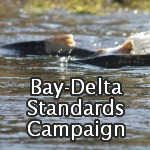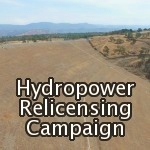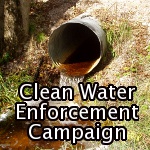On December 12, 2018, the California Department of Water Resources (DWR) and the United States Bureau of Reclamation (Bureau) concluded a series of water agreements relating to DWR’s State Water Project (SWP) and the Bureau’s Central Valley Project (CVP). On December 26, 2018, CALmatters published op-ed in which, Karla Nemeth, Director of the California Department of Water Resources (DWR) presents her perspective on “what new water deals mean.”
This post presents a different perspective.
The foundational agreement between DWR and the Bureau announced on December 12 is the Addendum to the Coordinated Agreement Central Valley Project/State Water Project. The Addendum to the “COA” modifies the 1986 agreement between DWR and the Bureau on how they divide up responsibility for meeting various regulatory requirements and how they divide up the benefits of water deliveries between SWP and CVP contractors.
Under the Addendum to the COA, the Bureau and the CVP generally get less responsibility and more water than under the 1986 COA. The SWP will be responsible for meeting more north-of-Delta and in-Delta flow and water quality requirements in Dry and Critically Dry water years. This will increase demands on Oroville Reservoir, DWR’s main north-of-Delta storage facility, when water is in short supply. Thus, the Addendum to the COA means that the SWP and the CVP will change how they operate their reservoirs.
The Addendum to the COA treats changes in the operations of California’s major reservoirs as strictly private water supply management issues to be negotiated by business interests and the agencies that enable them. However, as seen most clearly in the 2014 and 2015 drought years (and 2016 on the Stanislaus), drawing down SWP or CVP reservoirs increases the risk that their operators will be unable to meet flow, salinity and/or water temperature requirements in the following year without shorting deliveries to their highest priority “settlement” and “exchange” contractors. In 2014 and 2015, DWR and the Bureau faced low reservoir storage and low inflow. DWR and the Bureau jointly petitioned the State Water Resources Control Board (State Water Board) for “Temporary Urgency Changes” to flow, salinity and water temperature rules. The State Water Board granted these petitions to weaken flow, salinity and temperature requirements. As a result, almost the entire natural production of winter-run salmon in the Sacramento River failed, and Delta smelt disappeared, possibly to the point of extinction. These are public trust issues, not private ones. By any measure, they were significant impacts.
Legally, one way the public trust is protected from significant environmental impacts is through environmental review. However, DWR has declared that the Addendum to the COA is exempt from environmental analysis under the California Environmental Quality Act (CEQA), because the change is all within the range of (non-public) discretion DWR has always had in operating its reservoirs. The Bureau, for its part, issued a brief Environmental Assessment and a Finding of No Significant Impact under the National Environmental Quality Act (NEPA) for the Addendum to the COA, putting slightly more effort into determining that there is nothing to see here.
The “get” for DWR and the SWP from the Addendum to the COA is enshrined in another document, the Agreement to Address the Effects of the California WaterFix on Central Valley Project Operations, in which the Bureau agrees, for now, to stay on board with DWR’s Delta tunnels project (aka “WaterFix”), at least until the State Water Board issues a draft water rights decision for WaterFix. The Agreement to Address the Effects ultimately allows the Bureau the opportunity to become a partner in WaterFix or to decline, and promises that in any event DWR will “avoid, mitigate, or offset [WaterFix] impacts [to the CVP], if any, described herein under specified circumstances.”
Here are some of the things that the Agreement to Address the Effects means. First, it means that DWR won’t radically change the WaterFix project definition, for now. All the associated documents, processes and approvals that are based on the existing WaterFix project definition won’t be summarily thrown out. So DWR can continue pursuing WaterFix without facing a massive do-over of environmental review and three years of water rights hearings at the State Water Board. It means that DWR can tell the State Water Board that it will potentially use the Bureau’s water rights in operating the tunnels. And it means that DWR has the tenuous assurance that the Bureau may accept and comply with the substance of the Biological Opinions for WaterFix issued by the U.S. Fish and Wildlife Service (FWS) and National Marine Fisheries Service (NMFS). The Bureau is the federal action agency for the purposes of those BiOps, and would have extensive obligations under them. In the Agreement to Address the Effects, the Bureau has promised not to unravel that arrangement at least until the State Water Board issues a draft water rights decision.
As noted above, the Addendum to the COA, without adequate NEPA review and with no CEQA review at all, substitutes a private deal for public disclosure under CEQA and NEPA of the impacts of changed reservoir operations on the public trust. In combination with the Agreement to Address the Effects, the Addendum to the COA also creates a private deal to mitigate impacts of changed reservoir operations to CVP water users under WaterFix without mitigation of the impacts of changed reservoir operations to the public trust under WaterFix. Broader acceptance of such private resolutions would have the additional effect of reducing opposition in the WaterFix water right hearings to DWR’s position that reservoir operations are strictly a private matter, unfit for public comment, input or review.
CSPA has argued in its testimony in the WaterFix hearings that the State Water Board needs to put explicit carryover storage conditions on each of the north-of-Delta CVP and SWP reservoirs (Trinity, Shasta, Folsom and Oroville) to reduce the risk to fish. Separately, a number of water users have sought protection from foreseeable changes in reservoir operations under WaterFix that could reduce their water supply reliability. Folsom area diverters who protested the WaterFix petitions have asked for numeric carryover storage requirements in Folsom Reservoir to protect their water supplies. Other north-of-Delta diverters have sought to assure that changes in reservoir operations under WaterFix would not make less water available for their respective water deliveries. Conditions on reservoir operations in water rights permits for WaterFix (or as the result of any other proceeding) appear to be a deal-breaker for both the Bureau and DWR.
One of the goals of the December water deals thus appears to be to separate the water users who are WaterFix protesting parties (“protestants”) from environmental WaterFix protestants on issues of reservoir operations. Though a likely overreach at least in its timing, DWR sent a December 12 letter to many of the WaterFix protestants who are CVP contractors, asking these CVP contractors to dismiss their water rights protests and to not sue on any issues or proceedings relating to WaterFix. Much of the testimony that these parties presented in the WaterFix water rights hearings directly or indirectly addressed reservoir operations.
On December 12, DWR and the Bureau also concluded a cost sharing agreement to keep federal dollars coming to pay for the CVP’s share of the requirements under the existing Biological Opinions for the long-term operation of the existing SWP and CVP facilities. The Trump administration is working to re-write these BiOps, presumably to reduce federal obligations for both water and money. This cost sharing agreement appears to sunset once new BiOps for existing SWP and CVP facilities are issued. However, a December 12 letter from DWR Director Nemeth to Bureau Commissioner Brenda Burman entreats the Bureau to continue cooperation on a suite of matters relating to the SWP and CVP, and states, specifically: “Each of these actions must ensure an approach that enables compliance with state law.” This is important. Federal compliance with state law is no longer a given. In this regard, it is notable that the Addendum to the COA allows the possibility for the Bureau to withdraw from the COA in as little as six months.
In sum, the three agreements are an elaborate attempt by DWR to keep the Bureau on board with WaterFix, to keep the Bureau maintaining at least the appearance of complying with state law, to leverage federal funding, and to reduce CVP contractor opposition to WaterFix. DWR’s leverage is the SWP’s enormous Delta export pumping capacity and the potential that WaterFix may directly or indirectly increase CVP exports as well as SWP exports.
The three agreements are an elaborate attempt by the Bureau to increase water its supply deliveries and to reduce its regulatory obligations for both water and money. The Bureau’s leverage is the fact that DWR needs the Bureau to continue as a petitioner in the WaterFix water rights hearings and as a proponent in related proceedings. In addition, the Bureau’s leverage is that it can invoke the nuclear option of refusing to comply with state law in a variety of venues.
Together, DWR (passively) and the Bureau (actively) will use the Bureau’s leverage (potential non-compliance with state law) against the State Water Board in the update of the Bay-Delta Plan. The Board’s update could require both the SWP and the CVP to restore substantial amounts of water to the public trust. Both DWR and the Bureau, along with their contractors and other water users, will use the threat of federal non-compliance with state law, along with the carrot of federal funding, to promote the Voluntary Settlement Agreements that DWR and others also announced on December 12, 2018. DWR, the Bureau, and other water users will attempt to substitute these Voluntary Settlement Agreements for the State Water Board’s regulatory obligation to balance the public trust. This will be the subject of Part 2 of What the Water Deals Mean.









